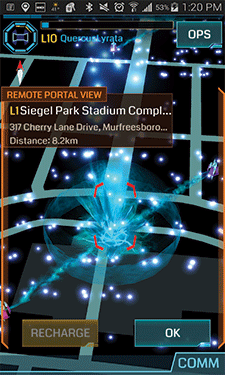 There’s a sculpture near my office that I never noticed was there, at least until I captured it. Now I walk past it with proprietary pride. It’s my first portal.
There’s a sculpture near my office that I never noticed was there, at least until I captured it. Now I walk past it with proprietary pride. It’s my first portal.
There is a game going on in your parks, and you may have no idea it’s there. Developed by Google and played in part on smartphones, Ingress is best described as a combination of geocaching and capture the flag. Two teams, Resistance (blue) and Enlightened (green), battle over portals. Portals are located at sites of public art, important buildings, and commemorative markers and signs. Even those “In memory of...” benches and trees often serve as portals, so chances are good that people are battling it out in facilities that you manage right now.
Players must stand within 40 meters of a portal if they want to capture it, so you can’t sit on your couch to play this game. The game explicitly encourages walking by tracking distance walked while playing and awarding badges for walking long distances. Many players state that what they like best is that the game encourages them to see new places, learn new things and meet new people.
Ingress can pose both challenges and opportunities to park managers. On the one hand, it’s a great way to get people to visit your parks. On the other hand, you may sometimes end up with unwanted visitors when your parks are closed or when players encroach on areas where they’re not allowed to be.
Here are three steps to help you both manage potential issues and maximize the opportunities that Ingress offers. First, you will need to learn about the portals in your parks. To do that, you’ll have to download the app and create an account. Take note of the signage, buildings or art in your parks that serve as portals, as well as how many portals are on your properties. You may find some surprises. When I checked NRPA’s headquarters on the map, I found a portal located right in the lobby!
Second, you should reach out to your local Ingress players. Players must work together to meet many of the objectives in the game, so active groups have formed in many communities. Understanding the needs and expectations of Ingress players will net the same benefits as with other users. Ingress groups can be a great resource of help and expertise in the game.
Finally, you may wish to incorporate Ingress into your programming efforts. Use the interpretive signs or art that serve as portals and work with local players to build missions that are both fun and informative. Encourage physical activity in your community by holding a walking challenge for Ingress players, and track their progress with their “distance walked” statistic. You might also consider hosting an Ingress event. Local groups often hold informal gatherings, and larger sites may even play host to international events with hundreds of participants. You can be a part of this by contacting your local group of Ingress players to help them coordinate events in your park.
Ingress is just one game that incorporates the GPS capabilities of our ubiquitous smartphones. We will likely see more applications of this technology in the years ahead. However, the better we understand how our parks are being used, the better we can serve the diverse needs of our participants.
Linda Oakleaf, Ph.D., is a Visiting Assistant Professor in the Leisure, Sport and Tourism Studies program at Middle Tennessee State University.

